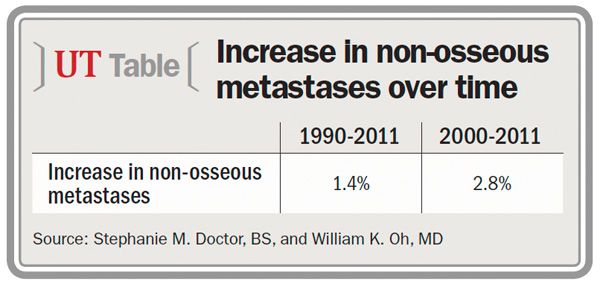Article
Incidence of non-osseous metastatic prostate cancer on the rise
Author(s):
New therapies that are extending survival of men with metastatic castration-resistant prostate cancer may also be contributing to an increasing trend for the development of non-osseous metastatic disease in these patients, according to a recent study.
New York-New therapies that are extending survival of men with metastatic castration-resistant prostate cancer (mCRPC) may also be contributing to an increasing trend for the development of non-osseous metastatic disease in these patients, according to a recent study.

The study, which was presented at the American Society of Clinical Oncology annual meeting in Chicago, was undertaken to investigate an anecdotal observation by senior author William K. Oh, MD, that increasing numbers of mCRPC patients were presenting with metastases at sites other than bone. Dr. Oh is chief of hematology and medical oncology and professor of medicine and urology at the Tisch Cancer Institute, Icahn School of Medicine at Mount Sinai, New York.
Temporal changes in metastatic disease patterns of men with mCRPC were investigated over the period of 1990 to 2011 using data from phase II or III trials that evaluated treatments for mCRPC. The analyses were based on 127 studies that reported baseline demographic data and information on non-osseous metastatic disease. To avoid skewing of the data, studies that required or excluded a specific site of metastases (except brain) were not included.
The results showed the rate of non-osseous metastases increased significantly between 1990 and 2011 at a yearly rate of 1.4%. Restricting the analysis to the years 2000 to 2011, the rate of increase in non-osseous metastases was 2.8% per year.
Looking at specific anatomic sites, the analyses showed the rate of lymph node metastases increased significantly both over the entire study period (2.2% per year) and during the last decade (3.3% per year), whereas there was no significant change in the rate of metastases to the liver.
“These findings confirm Dr. Oh’s clinical impression that the incidence of metastases to non-osseous sites has been increasing in men with mCRPC,” said first author Stephanie M. Doctor, BS, a graduate of the University of North Carolina, Chapel Hill. “Observations that the rate of increase was higher during the latter half of the study period as well as among men who had received prior chemotherapy versus those who had not lends support to the idea that the pattern may be due to new therapies increasing patient survival and perhaps pushing metastases to new sites other than bone.”
Call for standardization
In reviewing the mCRPC therapeutic trials for the analyses, the authors were also struck by the wide variation in definitions used for non-osseous metastases. To address this lack of uniformity, they are advocating an initiative to create a standardized set of criteria for identifying and reporting sites of metastasis in patients with prostate cancer.
“We know that the pattern of metastasis in prostate cancer has an impact on a patient’s symptoms, and it probably also influences efficacy of treatment. We believe that accurate interpretation of clinical trial results requires that the entire prostate cancer research community use the same language for defining metastases when reporting baseline characteristics and outcomes,” Dr. Oh told Urology Times.UT
Subscribe to Urology Times to get monthly news from the leading news source for urologists.
















